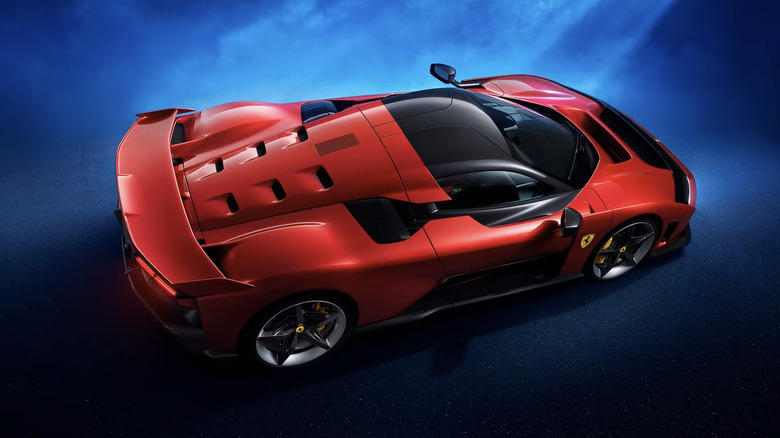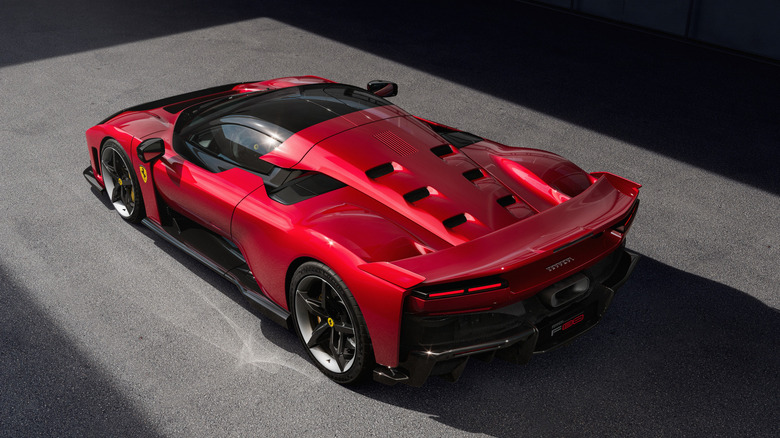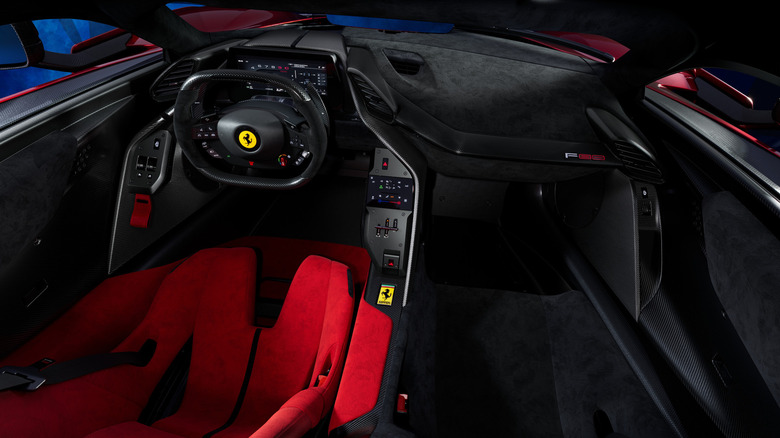Ferrari F80 Gives LaFerrari A Rare Successor With Record-Setting Horsepower
More than a decade after Ferrari unveiled its last halo car — the LaFerrari — the Italian sports car major finally has a new vehicle worthy enough to be called its successor. The company calls it the Ferrari F80, and it is touting it as the newest supercar in the line of iconic sports cars the company has made since it launched the Ferrari GTO in 1984. The Ferrari F80's bloodline goes back to several iconic cars, including the Ferrari F40 (1987), Ferrari F50 (1995), and the Enzo Ferrari (2002).
Historically, the engine tech used on Ferrari's halo cars is heavily inspired by the engines used on flagship motorsport cars from the era they launched. With the current generation of Formula 1 and World Endurance Championship (WEC) cars switching to V6 engines mated to a hybrid system, it was only natural for the Ferrari F80 to follow suit. This explains why the Ferrari F80 ditches the V12 engine we saw on the LaFerrari in favor of a 3-liter V6 engine that draws heavily from the engine used on the Ferrari 499P Le Mans Hypercar.
While this move may not go too well with V12 enthusiasts, the six-cylinder engine on the Ferrari F80 is the most powerful gasoline engine ever made by Ferrari. The F80's powertrain also includes additional electric motors that generate additional power. The combined power output from the gasoline-electric combination exceeds the 1,000-horsepower mark, firmly putting the Ferrari F80 in hypercar territory.
How much power does the Ferrari F80 make?
The Ferrari gets a 2,992cc V6 engine that alone makes a peak power of 900 horsepower, making it the most powerful gasoline engine ever made by the marquee sports car maker. As outlined earlier, this engine draws heavily from the powerplant used on the 499P race car, which was famously featured in two editions of the 24 Hours of Le Mans.
The Ferrari F80 is also the first Ferrari to ever feature electric turbo technology, which involves an electric motor placed between the turbine and compressor of each turbocharger. These fast-acting motors boost specific power output and also help improve the car's response while at low rpms.
As for the hybrid powerplant, the Ferrari F80 uses three electric motors developed by Ferrari itself at its Maranello facility. These motors give the car an additional 300 horsepower. Two of these motors are placed on the front axle, while the third motor is placed between the engine and the dual-clutch automatic transmission. The combined power output of this hybrid system on the Ferrari F80 totals 1,200 horsepower, making it among most powerful Ferrari cars ever.
With such copious amounts of power at its disposal, Ferrari went to great lengths to ensure that the car remained planted to the ground during high-speed runs. To achieve this, the company designed the vehicle to generate 2,204 pounds (1,000 kg) of downforce while doing speeds in excess of 155 mph (250 km/hr). Also helping the car with its exceptional downforce numbers is the rear wing-diffuser system, which alone generates 50% of the downforce applied to the rear axle of the car.
The gasoline-hybrid combination of the powerplants on the Ferrari F80 lets it do 0-60 mph (100 km/h) in 2.15 seconds and 0-124 mph (200 km/h) in 5.75 seconds.
Ferrari F80: The design and interior
The Ferrari F80 has been designed in-house by Ferrari at the Ferrari Styling Center, currently headed by Flavio Manzoni. The car looks markedly different from the LaFerrari it replaces, which may or may not be a good thing depending on what side of the design divide you stand.
Ferrari claims that the fresh design language of the F80 takes several design elements from older Ferrari cars, with a sprinkling of futuristic elements. When viewed from the sides, the most striking aspect of the F80 is the rear wing, with all design elements attempting to emphasize the muscularity of this single design element. The car also derives design cues from the Ferrari F40, with the most notable element being the vertical ends of the wheel arch.
Moving on to the interior, the first thing Ferrari mentions is its seating capacity. Right from the design stage of the F80, Ferrari designers wanted the car to give onlookers the visual perception of an enclosed Formula 1 car. This meant that the car had to feature the cockpit of a single-seat racer while also being able to accommodate a co-passenger.
Following a lengthy process that involved people from various departments, Ferrari was able to create a new solution that puts the driver at the center of the action. The passenger seat is slightly offset from the driver's and is integrated into the cabin, giving onlookers a perception of it almost disappearing from view.
Ferrari will make 799 units of the F80, and all 799 of them are reportedly already sold. The first deliveries of this $3.9 million supercar are set to begin toward the end of 2025, which is still a year away.


